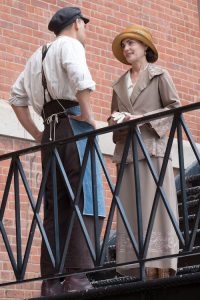

Visually, this inclination relies on the tight framing, fixed shots and flat lighting favored by TV productions, diminishing both the scope and impact of the narrative and performances.įortunately, the flowingly feminine period costumes by Candice Donnelly and Marcelo Zarvos’ jazzy score help maintain a sense of levity, even when the film apparently seems determined to tell its audience what to think and feel.Facebook Twitter Email MASTERPIECE� A Room With a View Following her revelatory role in last year’s Columbus alongside John Cho, Richardson harnesses Brooks’ boundless energy and infectious optimism as the very embodiment of Jazz Age social rebellion, even performing many of her own dance numbers with determined verve.Įngler tends toward containing all of this feminine assertiveness in a faithful representation of period morals that still feels rather stilted and forced. Norma’s plans and McGovern’s performance nearly get upended by Louise in a fierce, free-spirited turn from Richardson. Discovering her own agency leads in some unexpected directions, largely due to Moriarty’s highly imaginative attempts at plot resolution, which are far more relevant to the 21st century than the 1920s. Until the last half-hour, it’s a rather plodding process of experimentation and assimilation as Norma gains the insight and courage to seize her dreams. McGovern soberly strives to embody Norma’s personal transformation through the course of an eventful summer that turns out to be extraordinary in almost every sense. Anyone expecting to learn about her rise to stardom will have to settle for the self-awakening saga of a middle-aged Midwestern woman, which makes a good fit for Downton Abbey fans, but may frustrate viewers curious about Brooks’ meteoric career. These developments of course take place in the context of the recent achievements of the women’s suffrage movement and a worldwide reassessment of women’s role in society.įellowes foregrounds Norma’s growing independence at the expense of substantive insight into the development of Brooks’ early career and her transition from dance to silent movies. Striking up a friendship with the German immigrant janitor (Geza Rohrig) at the orphanage where she repeatedly but unsuccessfully entreats the resident nuns to disclose information about her parents, she glimpses the unexpected chance for romance and finds the strength to reject the constraints of her loveless marriage. While Louise begins her dance training, Norma pursues her real motive for coming to the city: visiting the orphanage where she was raised as a child in an attempt to learn the identity of her birth mother.Īs Norma begins to recognize the advantages of Louise’s self-directed personal agenda, she gains a newfound sense of purpose. Soon Norma and Louise are traveling by train to New York via Chicago, moving into a small apartment on the Upper West Side. The next day Norma meets Myra and agrees to chaperone Louise, which suits her mother just fine, since she doesn’t want to risk losing her preeminent role in Wichita’s arts community, but her decision aggravates Alan no end. Norma’s principal take-away from Louise’s rather flamboyant interpretive dance performance is that Myra is looking for a chaperone to accompany Louise to New York City to attend a summertime program at a prestigious dance academy. Norma Carlisle (McGovern) and her husband Alan (Campbell Scott), proud patrons of the arts. Her invitation to a dance recital by 15-year-old daughter Louise (Haley Lu Richardson) attracts the city’s savvy set, including Mrs. Traditional arts like dance and classical music remain dominant, however, allowing an otherwise inconsequential piano teacher and social climber like Myra Brooks (Victoria Hill) to arbitrate the city’s cultural agenda. A longtime passion project for McGovern, who also produces, The Chaperone overlaps Downton Abbey’s time frame, but remains culturally and esthetically rooted in the American Midwest, opening in Kansas, where even Wichita has caught the jazz bug.


 0 kommentar(er)
0 kommentar(er)
